Mykonos Landmarks and Monuments
(Mykonos, Cyclades, Greece)
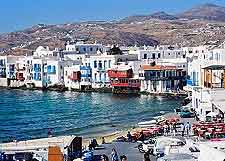
The island of Mykonos is brimming with traditional Cycladic architecture, with historical landmarks often enjoying the backdrop of a fishing village or seafront. Within Mykonos Town itself, the whitewashed houses and crammed into the paved alleys rather like boxes, and these really have become important landmarks in their own right, along with the island's archaeological sites and old churches, which are known for the pretty red roofs.
Amongst the island's most unusual of all its old landmarks are the windmills of Mykonos, which have become nothing short of an iconic and much-loved symbol of the island, being circular in their appearance, bright white, topped with a conical roof and featuring very distinctive 'sails'.
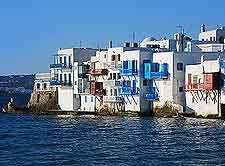
Little Venice
Address: Hora, Little Venice, Mykonos, Greece, GR
One of the most popular and familiar landmarks on the holiday island of Mykonos is the romantic area known as Little Venice. This colorful and charming neighbourhood has become well known for its elegant houses, which appear to perched rather precariously on cliff tops, directly above the sea. Located on the eastern side of Hora's Taxi Square and connected by the waterfront, the whitewashed houses and endless balconies within Little Venice truly are a sight to behold, enhanced further by their picture-postcard setting. This neighbourhood stretches from Alevkantra Beach, right up to the outskirts of the town's busting Kastro (Castle) area.
Open hours: daily - 24 hours
Admission: free
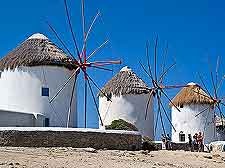
Windmills
Historically, the 'Upper Mills' of Hora and also those within Ano Mera served the local community, while the 'Lower Mills' were used more for grinding grain destined for offshore locations. Today, many of these traditional windmills have been restored and although they are no longer used to grind the grain, they are of great historical interest. The 'Bonis Mill' is now open to the public and serves as a small, but interesting museum, while other windmills have been converted into rather unusual homes.
Open hours: daily
Admission: free
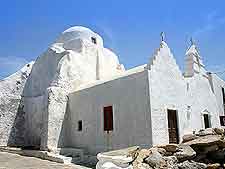
Church of Panagia Paraportiani
Address: Next to Delos Ferry Quay, Hora, Mykonos, Greece, GR
The most famous church on the island and highly regarded throughout Greece, no sightseeing trip to Mykonos can really being considered fully complete without first paying a visit to the Church of Panagia Paraportiani. Located in Hora, just beyond the Delos ferry quay and also extremely close to the Little Venice neighbourhood, the Church of Panagia Paraportiani is made up of four small chapels, with a further chapel being situated on an upper floor and only accessible via an outer stairway. The church is best views in the mornings, when services are not taking place. However, if you are of a religious persuasion, you may wish to attend one of the regular services held here. Interesting, the Paraportiani once served as a 'doorway' through the town's Medieval stone walls.
Open hours: daily, hours vary, usually open mornings
Admission: free, donations suggestion
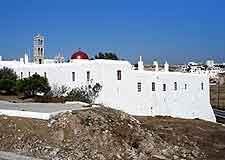
Ano Mera Village / Moni Panagias Tourlianis (Monastery)
Address: Ano Mera, Mykonos, Greece, GR
Tel: +30 22890 71249
The appealing village of Ano Mera lies approximately 7 km / 4 miles to the east of Hora and is actually the only inland settlement on the whole of Mykonos. Ano Mera serves as a pleasant contrast to the beaches and is based around a large central square, which is lined on three sides by a series of Greek tavernas, where spit roasts and seafood, such as Fisherman's Stew (Kakavia) have become local specialities. However, for sightseers, it is the monastery, Moni Panagias Tourlianis, which is likely to be of most interest. Built in the 6th century, the Moni Panagias Tourlianis boasts a dramatic marble bell tower, completely with detailed carvings and a beautiful 'iconostasis' screen, which was created in Florence during the latter part of the 18th century.
Open hours: daily - 09:00 to 13:00, 14:00 to 19:30
Admission: free
 The island of Mykonos is brimming with traditional Cycladic architecture, with historical landmarks often enjoying the backdrop of a fishing village or seafront. Within Mykonos Town itself, the whitewashed houses and crammed into the paved alleys rather like boxes, and these really have become important landmarks in their own right, along with the island's archaeological sites and old churches, which are known for the pretty red roofs.
The island of Mykonos is brimming with traditional Cycladic architecture, with historical landmarks often enjoying the backdrop of a fishing village or seafront. Within Mykonos Town itself, the whitewashed houses and crammed into the paved alleys rather like boxes, and these really have become important landmarks in their own right, along with the island's archaeological sites and old churches, which are known for the pretty red roofs.


